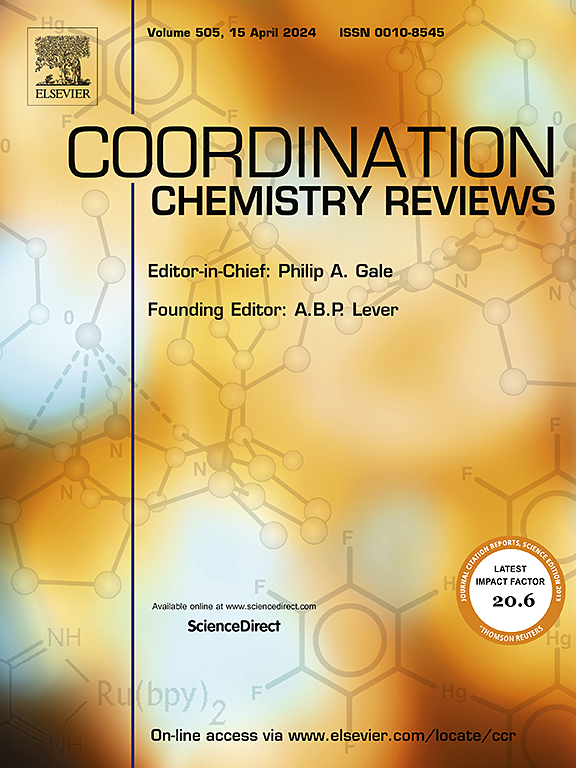脑动力学探针穿越血脑屏障策略及荧光成像研究进展
IF 23.5
1区 化学
Q1 CHEMISTRY, INORGANIC & NUCLEAR
引用次数: 0
摘要
血脑屏障(BBB)是一种选择性渗透屏障,在保护大脑方面起着至关重要的作用。然而,其保护机制的双重性质为开发针对大脑内活性物质的实时成像工具提出了重大挑战。随着新疾病的出现以及癫痫、阿尔茨海默病(AD)和胶质母细胞瘤等先前存在的脑部疾病的恶化,迫切需要扩大化学工具的范围,以完善这些疾病的诊断和治疗策略。在这种情况下,荧光探针在开发和优化能够跨越血脑屏障的新型诊断工具方面显示出显著的潜力。它们的优点包括分子量可调,脂质水分配系数可控,以及活体实时成像的能力。本文综述了用于穿越血脑屏障的荧光探针的评价方法和理化参数。综述了荧光探针在检测脑内活性物质方面的研究进展,包括活性氮(RNS)、活性氧(ROS)、活性硫(RSS)、蛋白质和神经递质等。这些研究突出了开发用于血脑屏障穿透的高效荧光探针的方法和实用性。此外,本文简要介绍了与荧光探针穿越血脑屏障相关的挑战,并提出了未来技术进步的潜在策略。这些发现为开发用于脑原位成像的新型光学探针提供了有价值的参考。本文章由计算机程序翻译,如有差异,请以英文原文为准。

Advances in probe crossing the blood–brain barrier strategies and fluorescent imaging for brain dynamics
The blood–brain barrier (BBB) is a selectively permeable barrier that plays a crucial role in protecting the brain. However, the dual nature of its protective mechanisms presents significant challenges for the development of real-time imaging tools targeting active substances within the brain. With the emergence of novel diseases and the worsening of pre-existing brain disorders such as epilepsy, Alzheimer's disease (AD), and glioblastoma, there is an urgent need to expand the repertoire of chemical tools to refine diagnostic and therapeutic strategies for these conditions. In this context, fluorescent probes have shown remarkable potential for the development and optimization of novel diagnostic tools capable of crossing the BBB. Their advantages include adjustable molecular weight, controllable lipid water partition coefficients, and the capability for real-time imaging in living organisms. In this review, we discuss the evaluation methods and physicochemical parameters of fluorescent probes designed to cross the BBB. We also summarize recent studies on fluorescent probes for detecting active substances in the brain, including reactive nitrogen species (RNS), reactive oxygen species (ROS), reactive sulfur species (RSS), proteins, and neurotransmitters. These studies highlight the methodologies and practicalities of developing efficient fluorescent probes for BBB penetration. Furthermore, this paper briefly addresses the challenges associated with fluorescent probes crossing the BBB and proposes potential strategies for future technological advancements. These insights provide valuable references for the development of new optical probes for in situ brain imaging.
求助全文
通过发布文献求助,成功后即可免费获取论文全文。
去求助
来源期刊

Coordination Chemistry Reviews
化学-无机化学与核化学
CiteScore
34.30
自引率
5.30%
发文量
457
审稿时长
54 days
期刊介绍:
Coordination Chemistry Reviews offers rapid publication of review articles on current and significant topics in coordination chemistry, encompassing organometallic, supramolecular, theoretical, and bioinorganic chemistry. It also covers catalysis, materials chemistry, and metal-organic frameworks from a coordination chemistry perspective. Reviews summarize recent developments or discuss specific techniques, welcoming contributions from both established and emerging researchers.
The journal releases special issues on timely subjects, including those featuring contributions from specific regions or conferences. Occasional full-length book articles are also featured. Additionally, special volumes cover annual reviews of main group chemistry, transition metal group chemistry, and organometallic chemistry. These comprehensive reviews are vital resources for those engaged in coordination chemistry, further establishing Coordination Chemistry Reviews as a hub for insightful surveys in inorganic and physical inorganic chemistry.
 求助内容:
求助内容: 应助结果提醒方式:
应助结果提醒方式:


